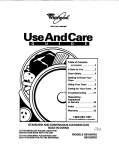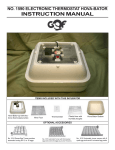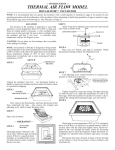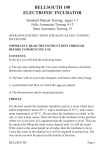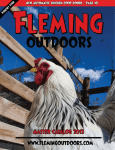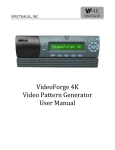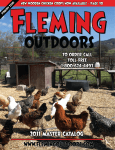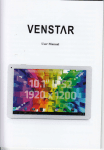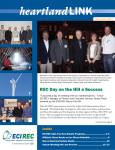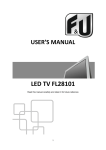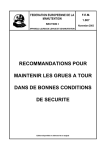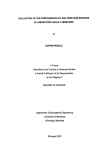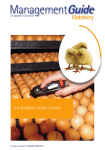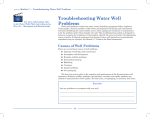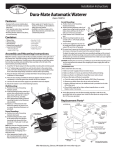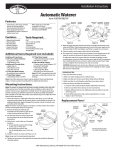Download Cabinet Model Instructions
Transcript
INSTRUCTIONS For model 1502 - 1527 - 1536 - 1550 - 1570 incubators and 220 Volt equals NOTE: It is recommended that you operate the incubator with a small quantity of inexpensive eggs to be assured of your operating procedure and the performance of the incubator before attempting to hatch large quantities of eggs or expensive eggs. (See warranty on page 6) LOCATION The location of the incubator is important to successful operation. A thermostatically controlled room temperature between 75oF to 80oF (24oC to 27oC) degrees with fresh air without drafts is ideal. Room temperatures from 55oF to 90oF (13oC to 32oC) are acceptable but good temperature control in the incubator is obtained when the room temperature is held within a few degrees. A room temperature that changes 10oF (5oC) from day to night could result in a ½ degree change inside the incubator. The back of the incubator where the vents are located should be placed no closer to a wall or barrier than 12 inches (30cm) in order to have free air exchange within the room. Avoid areas of strong sunlight or air ducts that could influence the temperature in the incubator. SET UP Unpack the incubator and plug the electrical cord into the proper voltage socket. If used in countries other than the USA or Europe the electric plug may have to be removed and a suitable type plug installed. When plugged in, the incubator fan will blow air towards the door and the light near the cord set will shine provided the room temperature is below 94F (34C). For setting incubators such as the 1502 locate the turner switch on the upper left outside near the rear of the incubator. Toggle this switch to the momentary on position (it will have to be held in this position). With the incubator door open, the trays should be seen to turn slowly while holding the switch in this position. Releasing the toggle switch will return it to the center position, which is the off position for the turner. Using this switch will allow the racks in the incubator to be leveled in order to install or remove the egg trays. Moving the toggle switch to the opposite position will cause the toggle to snap in place. This is the automatic turning position. Be sure that the egg trays are fully pushed in so that they do not obstruct the racks from turning before putting the switch in the automatic position. The switch must be in the automatic position in order for the incubator to turn the eggs every two hours automatically. TEST FOR ASSURANCE THAT TURNER IS WORKING: It is recommended that each week the following test be preformed: Using the toggle switch, run the turner until the trays are level and return the switch to the ON position. Look to see if the trays remain level. If not, then re-level so that they remain level. Put the switch in the ON position. Check the tray level after 3 hours. If trays are not level then the turner is operating properly. If no turning has taken place, then timer may need to be replaced. There are vent holes in the back of the incubator. Three at the top and three at the bottom. The outer vents have moveable covers while the center vents have no covers. For normal operation, the outer vents are closed. Do not cover the center vents, as constant fresh air exchange is necessary for the development of the eggs. The incubator comes with a moisture pan and wick pads. Normally the moisture pan is filled with water and placed on the fan shelf between the runners. The wick pad is added when additional moisture is required usually at time of hatch. If the optional automatic moisture pan is used, place the tank on top of the incubator and attach the hose to the moisture pan nipple. Next thread the shut off clamp on to the hose so that it will be between the quick disconnect and the tank. Attach the hose to the tank nipple and fill the tank with water. Depth of the water in the moisture pan is not important for humidity but may be adjusted by bending the brass float arm slightly. Toggle Switch Humidity Control Vents Humidity Pan with wick pad 1 The thermometer comes with wicks. The purpose of the wicks is explained in the HUMIDITY section. The thermometer is placed in the small hole marked THERMOMETER / HYGROMETER on the upper left outside of the incubator. The thermometer should be pushed fully into its hole with the dial portion on the outside of the incubator. If the hole is snug, avoid twisting the dial while the probe is in the hole as this could loosen the dial and move the 100F-calibrated setting. In the unusual event that the thermometer looses calibration, it can be recalibrated by placing it in a known 100F atmosphere, then hold the base of the probe at the dial with pliers so that the card may be rotated. Align the 100F mark under the pointer and then re-tighten the probe. No. 3018 in Postion TO REGULATE Important – do not confuse the word THERMOMETER (the dial which shows temperature) and THERMOSTAT (electronic or wafer switch that controls heat). The incubator is equipped with an electronic thermostat, No. 3255, and a mechanical wafer auxiliary thermostat, No. 3124. The wafer thermostat is a stand-by thermostat and is not connected to the incubator’s heat system. It is used whenever the electronic thermostat is to be by-passed and does not need to be regulated at this time. Store the wafer and adjusting screw for possible future use. The electronic thermostat will have to be adjusted for the proper temKnob used to perature before setting the eggs. regulate operatThe electronic thermostat is regulated by the black ing thermostat knob on the left side of the incubator while facing the door. Arrows next to the knob show direction of turn for increasing and decreasing the temperature. The knob will make 10 full turns from high to low. The range of the thermostat is from 94oF to 104oF (34oC to 40oC). The light nearest the cord set is the heater light and it shines when the heater is on. When the temperature in the incubator is below 94oF (34oC) it will shine most of the time and then begin to blink on and off as it approaches the set point Begin by turning the knob toward DECREASE until it stops then turn it five complete turns towards INCREASE. Close the vents doors on those vents that have them in the back of the incubator and close the door to the incubator and latch it with the incubator operating. Allow the incubator one hour to heat up. If the temperature is above 100oF (37.8oC) after one hour then turn the knob toward decrease by one turn and recheck in fifteen minutes. One complete turn of the knob is approximately one degree in temperature. If the temperature is below 100oF (37.8oC) by three degrees or less after one hour, do not adjust the knob but wait at least four hours before making any adjustment. The walls, water pan and interior of the incubator take time to heat up and for the thermostat to settle to a proper temperature. THE CORRECT TEMPERATURE FOR MOST EGGS IS 100o F (37.5oC). Mark the knobs pointer against the incubator for position reference for the proper setting. It is recommended that the incubator be allowed to run for a day at its set temperature before placing the eggs in the trays. When many eggs are added, expect the temperature to come back only to within a degree below set point for almost a day. If temperature has not fully recovered at that time, then make slight adjustments with the control knob. Keep in mind that large corrections of the control setting can result in over shoot and under shoot of the desired setting. After two weeks, it maybe necessary to turn the thermostat toward DECREASE in order to maintain proper temperature. This is due to the natural heat of the chicks inside of the shells. With large eggs such as turkey or goose it may be necessary to reduce the setting temperature by half a degree after the 3rd week. In the event of an electronic thermostat failure, the electronic unit can be disconnected inside of the incubator and the heat system wired to the wafer thermostat. To regulate the wafer thermostat, screw the wing nut onto the L shaped adjusting screw. Place the adjusting screw into the hole for the wafer thermostat from the outside and screw it into the bracket located on the inside. After a few turns, place the wafer into the bracket inside of the incubator and screw it onto the end of the adBackup thermostat justing screw so that it is snug. Adjust the with wafer installed. temperature in the same manner as the elec(Use only if electronic tronic thermostat. The wafer thermostat has thermostat fails) o o o o a range of about 78 F to 110 F (25 C to 44 C). 2 VENTILATION & HUMIDITY For most eggs such as poultry and game birds, the outer vents should be kept closed, and the incubator’s moisture pan filled with water until a few days before scheduled hatch. The center vents should be left open at all times. During the last couple of days, add a wick pad to the water pan to increase humidity and do not change vent settings. This procedure is simple and works for most locations and eggs. It avoids the complexities of the methods to follow. It is necessary for the egg to lose some of its moisture during incubation; however, the purpose of supplying water in an incubator is to prevent excessive drying out of the natural moisture in the egg. The rate of evaporation from the egg is determined by the type of egg, pore density and size and the humidity of the air. Methods of determining the proper rate of evaporation are by judging the size of the air sack in the egg, the hygrometer reading, or by weighing the egg with a scale. Humidity is adjusted in the incubator by adjusting the vents (opening the vents decreases humidity) or changing the surface area of the water (add wick pads to increase or cover part of the pan to decrease humidity). Weighing the egg with a very accurate scale is the best way of establishing proper humidity. Most types of eggs should loose about 12% to 14% of their weight during incubation. Raise humidity if too much weight is being lost, reduce humidity if weight loss is too little. By using the known weight of the egg before incubation, multiply this number by the desired percentage of weight loss to get the desired weight loss. Divide this figure by the number of days for incubation and it will yield the average desired weight loss per day. Compare the desired weight on a given day to the actual weight for that day. The egg maybe +/- one percentage point of the desired percent. The incubator is supplied with a dial thermometer, which can be used as a hygrometer. To do this, first establish the proper setting on the thermostat by using the dial thermometer. Do not move the thermometer to any other location as it may affect its calibration. The thermometer/hygrometer comes with two wicks. Wet one of the wicks which is a cloth tube about 6” long. Place the thermometer probe down the center of the wick by several inches and place the other end of the wick into the water of the moisture pan. Close the door of the incubator and allow about 30 minutes for it to return to its temperature of 99.5F, which has already been set on the thermostat. Because of the evaporation of water from the wick, the thermometer now reads lower than the 99.5 setting (probably in the 83F to 86F range). Make any adjustments to humidity as described in the previous paragraph. Do not use the hygrometer for more than 6 hours as the wick may crust over with minerals from the water and give an incorrect high reading. Once the humidity level is established, it is not likely to change very much, so reHygrometer wick installed on move the wick and return it to the thermometer function. Reprobe and placed in humidity pan check in the same way for proper hatching levels. HATCHING About three days before the expected hatch date move the eggs from the turning tray(s) and lay them in the hatching tray(s) in their natural, unsupported position. It is recommended to use a separate hatcher such as the Model 1550 as temperatures are usually ½ to 1F degree cooler for hatching with increased humidity. The 1502 incubator has a hatching tray in the bottom, which will allow for hatching eggs while newer eggs are being turned in the setting trays. If all eggs in the 1502 are to hatch, then the turning trays can be leveled and the eggs placed on the wire floors of the setting trays. Small chicks such as OR Move all eggs set in a quail may require a cover over the trays similar to the hatching tray Move eggs that are due to No. 1502 incubator to a cover. Covers are not used for large chicks. For hatching, set the hatch to the hatching tray model No. 1550 Hatcher incubator to 99.5F (37C) and add a wick pad to the moisture pan. A second pad maybe added to the pan if higher humidity is desired. This setting should meet the needs of most types of eggs. A hygrometer reading from 88F to 93F (31C to 34C) is desired. In the 1502 incubator with other eggs not ready to hatch, lower the temperature ½ F and add one wick pad for the few days of the hatch. If possible, avoid opening the door during the hatch as this removes warm, moist air resulting in a slowed or damaged hatch. As soon as the hatch is completed return the 1502 to its normal temperature and humidity settings. If eggs hatch a day or two early, decrease the temperature ½ degree during the entire incubation period on the next setting. If the eggs hatch a day or two late then increase the temperature ½ degree. For poor hatches that hatch on expected day, consider an adjustment in humidity settings. Humidity Pan with wick pad 3 BROODING Remove chicks to the brooder within 24 hours after hatching as soon as they are dry. If some of the eggs are late hatching, removal of chicks should be done quickly as possible to prevent chilling of unhatched eggs. If some eggs appear hatchable, continue the hatch for a day or two more. Chicks hatching a few days beyond expected date are usually weak and may not survive. Discard eggs that are over four days beyond hatch date. When chicks are removed from the incubator they must have a place that is warm and dry. A brooder should have one section that is heated, with a temperature of 100F (37C) for small birds like quail or 95F (34C) for larger birds like chickens. Maintain this temperature for the first week and then lower it 5 degrees (F) each week there after down to normal room temperature. If temperatures are a little too warm the chicks will move to the cooler parts of the brooder on their own. Place food on a flat surface near the feeder. Avoid slick surfaces like cardboard, plastic or flat newspaper as young chicks have difficulty standing on them. Water should be available in a proper drinker for the type chicks. Small birds such as quail can easily drown in large drinkers so rocks or marbles may need to be used at first if the drinker is not made especially for them. The GQF catalog has suitable brooders, feeders and drinkers. GQF Vitamins Plus is also recommended for the first seven days to improve survivability. G.Q.F. has many types of brooders, feeders, and waterers available CLEANING AND SERVICING If practical, the incubator maybe wiped down with a disinfectant such as Tek-Trol. Even a mild detergent maybe used and the trays placed in strong sunlight to dry. There is aluminum clean out pan on the floor of the incubator, which should be cleaned after each hatch. Moisture pans and tanks should also be cleaned from time to time. Hygrometer wicks and wick pads may begin to turn brown from mineral stains. These maybe used again by placing the stained portion into the water. Wicks and pads can only be used a few times and then must be replaced. Cleaning and repairs in the rear of the incubator can be done by first unplugging the incubator from the power and then removing the screws from the back panel. Carefully wipe away any feather dust with a moist Tek-Trol, available from G.Q.F. sponge. Replacement parts are available from GQF. The fan motor is sealed and does not require oiling. can be used to sanitize incubators and hatchers. Thermostats and turner parts should give long service but parts are available when needed. ACCESSORIES EGG RACK POSITIONERS FOR CABINET INCUBATORS Plastic egg rack positioners offer the most efficient system for gathering, spray disinfectant treating and storing of eggs. At time of setting eggs, just remove loaded egg rack positioners from storage area to the incubator setting trays. No. 0243 - SET OF 6 QUAIL EGG RACKS, each No. 1502 setting tray will hold 2 egg racks (248 quail eggs) for a total of 744 eggs per incubator (racks single stacked). Molded posts on each rack permits double stacking for a total of 1488 No. 0243 No. 0246 quail eggs. (Caution: GQF HATCHING trays hold a maximum of 250 quail eggs). N o . 0 2 4 5 - S E T O F 6 P H E A S A N T E G G R A C K S , e a c h r a c k h o l d s 5 9 e g g s , f o r a t o t a l o f 3 5 4 e g g s p e r 1 5 0 2 i n c u b a t o r. No. 0246 - SET OF 6 UNIVERSAL EGG RACKS, each rack holds 45 bantam to chicken sized eggs, for a total of 270 eggs per 1502 incubator. No. 0248 - SET OF 6 EXTRA-LARGE EGG RACKS, each rack holds 30 extra large eggs (Turkey, Duck, etc.), for a total of 180 eggs per 1502 incubator. A U T M O TAT I C INCUBATOR HUMIDITY Consists of 5 Gal. reserve tank, connecting hose, with quick disconnect coupling and constant level humidity pan with 2 humidity pads, for increased humidity at time of hatch. For all GQF Cabinet Incubators. No. 3030 - Automatic Incubator Humidity No. 4502 - Pkg. 2 Extra Humidity Pads No. 4510 - Pkg. 10 Extra Humidity Pads CLEAR ACRYLIC DOOR FOR ALL CABINET MODEL INCUBATORS AND HATCHERS CLEAR ACRYLIC DOOR gives full frontal view of interior of incubator, to permit checking of hatching progress, tray turning, water level, etc. No. 3065 - Clear Acrylic Door 311/4” x 151/2” x 1/2” - Sold as an accessory for customer’s installation only. ORDER ACCESSORIES BY PHONE: 912-236-0651 - OR - ON THE INTERNET AT WWW.GQFmfg.COM 4 GENERAL INCUBATOR OPERATING INSTRUCTIONS FOR SEVERAL SPECIES OF BIRDS Bobwhite Quail Requirements Incubation period (days) 23-24 Temperature (F) Cotumix Quail Ostrich 17 42-48 Emu Duck 43-50 100 100 84-86 84-86 70 70 Final day of egg rotation 21 15 38-40 44-46 Temperature during final 3 days of incubation (F) 99.5 99.5 96-96.5 96-96.5 Humidity during final 3 days 90-94 of incubation (wet bulb, F) 90-94 Humidity (wet bulb, F)* Duck Muscovy Goose Guinea Pheasant Peafowl Chicken, Turkey Chukar Rheas 35-40 28 35-37 28-34 28 23-28 28-30 100 100 100 100 100 84-86 84-86 86-88 83-85 82-84 83-85 30-33 25 31 25 25 21 25 19 98.5 99.5 99.5 99.5 99 99.5 99.5 90-94 90-94 90-94 90-94 92-95 90-94 96.5-97 96.5-97 96.5-97 100 75 75 Bantam 85-87 88-90 * % Weight loss: Total weight loss from beginning to end of Incubation should be 12%-15% for morst eggs % Weight Loss = Original wt. - Present wt. x 100% Average Daily Wt. = Original wt. Loss Required Timer Motor with switch No. 3023 Swing Arm No. 3028 Sw in Arm g Ca m Timer Cam Drive Motor No. 3022 W E T Side Mounting Bracket Mounting Screw Side Mounting Bracket B U L B Set Screw Side View Foot for mounting to fan shelf 25 17 21 28 23-24 100 100 100 100 100 80-82 82-86 84-86 25 21 22 15 99.5 99.5 99.5 99.5 99.5 90-94 90-94 90-94 90-94 90-94 85-87 83-85 Original wt. X .14 (Based on 14% total loss) Incubation Period DRY BULB TEMPERATURES Toggle Switch No. 3025 Switch for Drive Motor No. 3024 Pigeon CONVERSION OF WET/DRY BULB READINGS TO PERCENT OF RELATIVE HUMIDITY Diagram of incubator turner. Complete turner is item No. 3021 Timer Motor with switch No. 3023 Grouse Partridge View from rear of incubator T* E M P E R A T U R E S TURNER PROBLEM CHECK LIST PROBLEM CHECK FOR: Turner fails to turn 1—TEST FOR ASSURANCE THAT TURNER IS WORKING as shown on automatically Page 1 of Incubator Instructions. but will turn manually. 2—Remove back of incubator. DO NOT TOUCH ANY PART OF TURNER WHILE INCUBATOR OR TURNER IS PLUGGED INTO POWER. Check to see if turner light comes on when switched to Automatic. If not, check for loose wires or connections at toggle and other switches. Check all slip on connections for good contact. If Timer Cam marks do not show signs of rotating in 30 minutes or if Timer Switch seems defective, No. 3023 Timer with Switch will need to be replaced. Turner fails to turn 1—Check to be sure trays inside have not been pushed all the way to back on manual or automatic or some other obstruction that has jammed the trays. 2—Be sure incubator and turner is plugged into outlet that has electric current and that pilot light is on when switched to automatic. 68 69 70 71 72 73 74 75 76 77 78 79 80 81 82 83 84 85 86 87 88 89 93 91 92 93 94 95 85 90 95 96 97 98 99 100 101 102 41 44 47 50 33 56 60 63 66 70 73 77 80 84 80 92 96 100 31 34 36 39 41 44 47 50 53 55 58 62 65 68 71 74 78 81 85 89 92 96 100 23 25 28 30 32 34 37 39 42 44 47 49 52 35 57 60 63 66 69 72 76 79 82 86 89 93 96 100 22 24 26 28 30 33 35 37 40 42 45 47 50 32 55 58 61 64 67 70 73 76 79 82 86 89 93 96 21 23 25 27 29 31 33 36 38 40 43 45 48 50 53 55 58 61 64 67 70 73 76 79 83 86 89 93 19 2.1 23 25 27 30 32 34 36 38 41 43 46 4 51 53 56 39 61 64 67 70 73 76 79 83 86 89 18 20 22 24 26 23 30 32 34 37 39 41 44 46 48 51 54 56 59 62 65 67 70 73 76 80 83 86 17 19 21 23 25 27 29 31 33 35 37 39 42 44 46 49 51 54 57 59 62 65 68 71 74 77 80 83 16 18 20 21 23 25 27 29 31 33 36 38 40 42 43 47 49 52 54 57 60 62 63 68 71 74 77 80 15 17 18 20 22 24 26 28 30 32 34 36 38 40 43 43 47 50 52 55 57 60 63 65 68 71 74 77 3—Remove back of incubator. DO NOT TOUCH ANY PART OF NOTE: The above chart is for sea level readings. A general rule of adjustment would be to add 1 to the percent value shown in the body of the chart for each 2500 feet of elevation above sea level. TURNER WHILE INCUBATOR IS PLUGGED INTO POWER. Check for loose wires, loose connection rods or jammed tray. Turns constantly when 1—Switch for Drive Motor is loose and has moved away from Swing Arm switched Cam. Loosen screws holding Switch, push switch closer to Cam and while to automatic holding it closer to Cam, tighten screws. Avoid over tightening as you *To obtain lower wet bulb readings, recommended for ratite eggs, we recommend using an inexpensive room dehumidifier, available at Sears, WW Grainger and other outlets. could break switch housing. 5 INCUBATION TROUBLESHOOTING CHART Symptoms Probable Causes Many clear eggs. No blood (Determined by candling, then broken out appearance) Slight blood rings Many dead germs Pipped eggs not hatching Hatch non-uniform Hatching too early Hatching too late Sticky Hatch Cripples and Malpositions *Very large, soft-bodied weak chicks Mushy chicks. Dead on trays, bad odor Rough navels Temperature reading not constant Incubator fails to heat (Continue hatch if begun. Hatch may occur later than expected because of temperature drop.) Fan Rattles Hygrometer reading above 94 o Suggestions 1. Infertility. Too few males, too many males, males too old, Inactive, or frozen combs 2. Embryo died early 1-2 days 1. Use young, vigorous males. 2. Do not hold eggs longer than 14 days. Keep at temperatures of 50°-55°F. in moist atmosphere. Gather often. 3. A. Improper temperature B. Fumigation 4. Improper care of eggs before setting 3. A. Check accuracy of thermometer, Check thermostat, heating element, current supply. Check operating temperature against instructions. B. Do not fumigate at high concentrations during the first 5 days of age. 4. See suggestions (2) above. 5. Temperature too high or too low 6. Improper turning of eggs 7. Improper feeding of flock 8. Breeding (low hatchability inherited) 9. Improper ventilation, insufficient oxygen 5. See suggestion (3) above. 6. Turn two times daily - same time morning & evening 7. Check vitamin and mineral content of breeder mash. 8. Avoid close inbreeding 9. Increase ventilation of incubator and incubator rooms, avoid draft 10. 11. 12. 13. 10. Increase humidity during incubation (wet bulb 82°-86°) add wick pad last 3 days (wet bulb 90°-92°) during hatching time 11. See (3) above and see “Hatching” page 3 12. See (3) above and see “Hatching” page 3 13. See (3) above and see “Hatching page 3 Insufficient rnoisture Too much moisture Too low temperature Too high temperature 14. Temperature too high 15. Too low moisture 16. Improper turning or setting 17. Hatching trays too smooth 14. See (3) above and see Hatching” page 3 15. See (10) above 16. See (6) above. Set eggs large end up. 17. Use wire bottom trays or crinoline 18. Low average temperature 19. Poor Ventilation 20. Navel infection in incubator 18. See (3) above and see “Hatching” page 3 19. See (9) above 20. Careful cleaning and fumigation of incubator between hatchings. 21. High temperature or wide temperature variations. 22. Low Moisture 21. See (3) above 22. See (10) above 23. Incubator in unheated room or barn where temperature varies 24. Improper adjustment of thermostat (can be caused by someone tampering with adjusting knob 23. Keep Incubator In room with uniform temperature and where temperature is never below 50°. 24. Readjust thermostats. Make slight adjustments with adjusting knob and wait 15 minutes for temperature to stabilize. 25. Thermostat failure 26. Improper setting of thermostat 27. Power failure, incubator unplugged or poor plug connection 28. Loose wire connection 25. switch to back up thermostat 26. Turn adjusting knob to increase heat until pilot light comes on. 27. If fan is not running, electricity is not getting to incubator check fuses and plug connections. 28. Remove back of incubator and check for loose wires. 29. Blade bent 30. End play in motor shaft 29. Remove and straighten blade or replace with new blade 30. Place block under back legs of Incubator 31. Dry wick on hygrometer 31. Wash calcium deposits from wick or replace with new wick. Reference Number Catalog Number 1 - POWER CORD...............................No. 3048 2 - PILOT LIGHT....................................No. 3017 3 - ELECTRONIC THERMOSTAT........No. 3255 4 - Aux. THERMOSTAT..........................No. 3124 5 - HEATER GUARD 6 - MOISTURE PAN/PAD(S).................No. 4500 7 - PORCELAIN INSULATOR 8 - HEAT ELEMENT...............................No. 3014 9 - FAN BLADE.......................................No. 3013 10-FAN MOTOR......................................No. 3011 11- TIMER WITH SWITCH....................No. 3023 12-TURNER LIGHT...............................No.3017 13-TURNERTOGGLE SWITCH...........No.3025 Reference Number Catalog Number 14-DRIVE MOTOR.................................No. 3022 15 - AUTOMATIC TURNER.................No. 3021 16 - SWING ARM WITH CAM..............No. 3028 17 - ROLLER Switch for Drive Motor...No. 3024 18 - FAN MOUNT...................................No. 3026 19 - CONNECTING BAR.....................No. 3041 20 - QUAIL EGG POSITIONERS........No. 0205 21 - BACK SUPPORT...........................No. 3042 22 -1502 SET. TRAY - 24.5” x 12.75”...No. 3067 23 -1550 TRAY CVR.-25” x 14.25”......No.3068 24 -1550 HATCH TRAY - 24.5”x14”.....No. 3066 25 -1502 SETTING TRAY RACK/23”..No. 3069 LIMITED WARRANTY GQF Mfg. Co.. Inc. guarantees against defect for a period of 1 year from date of purchase. Notify GQF Mfg. Co. of any defective Items, giving catalogue number and name of Item and Just what is wrong with Item. Send copy of invoice showing date of purchase. GQF Mfg. Co. will send replacement or notify regarding return. Returning of items without written permission will be at owner’s expense. Whereas GQF Mfg. Co. has no control over usage of equipment supplied, It assumes no responsibility for losses or damage from their equipment other than replacement of defective parts. No guarantee on hatchablilty of eggs. Do not expose electrical parts to water. Installation of electrical parts should be done by qualified electrician. G.Q.F. Manufacturing Company P.O. Box 1552 Savannah, GA 31402-1552 USA 6






